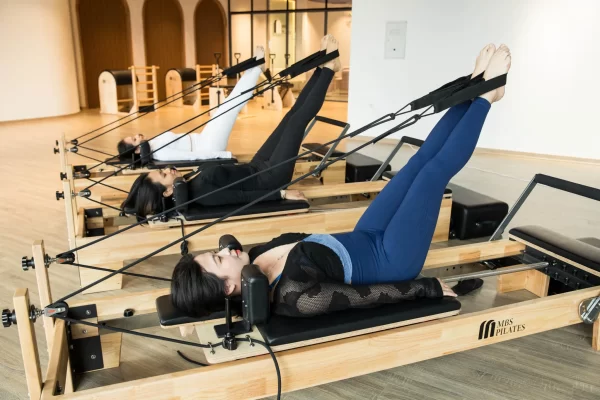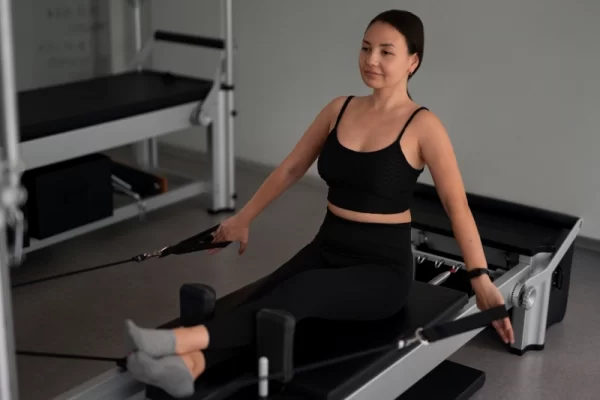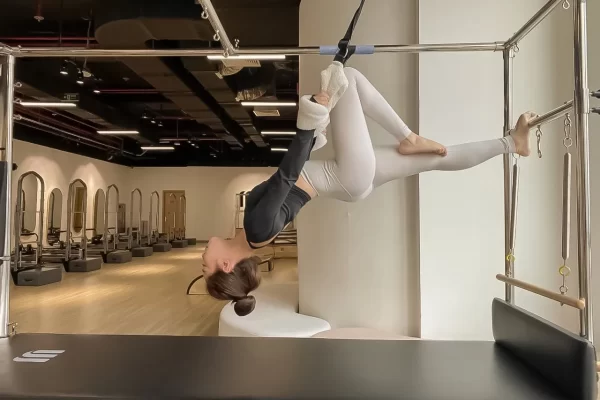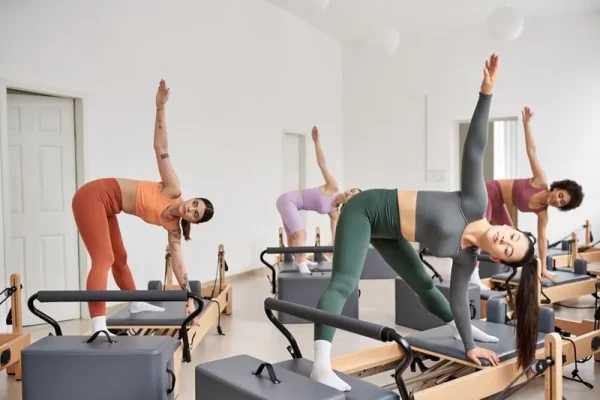Warm up before Pilates: The key to an effective workout
18/11/2025Before embarking on any Pilates session, proper warm-up is essential. Warming up not only prepares your body for complex Pilates movements but also reduces the risk of injury and enhances the effectiveness of your workout. In this article, we will explore the benefits of warm up before Pilates and provide you with the best warm-up exercises.
Understanding the importance of warm up before Pilates
Warming up before starting a Pilates session is an essential step if you want an effective and safe workout. This is not just a matter of performing a few gentle movements to loosen up your muscles and tendons, but also a way for your body to prepare for the exercise ahead.
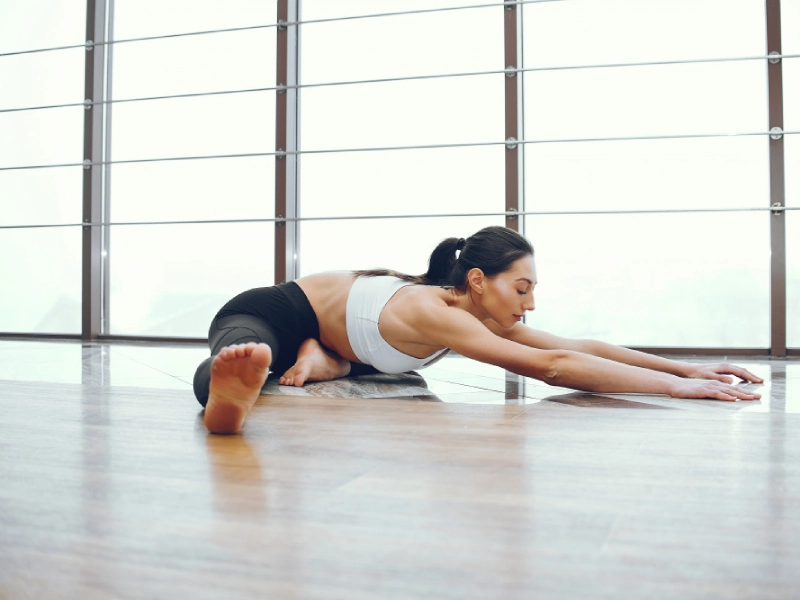
Warm up before Pilates involves performing gentle exercises to loosen muscles and tendons.
These exercises act as a form of signalling to the brain to send information to the organs to prepare. When you warm up, the circulatory system and muscle groups have time to adapt and gradually become accustomed to higher-than-normal exercise intensity, avoiding shock, thereby reducing the risk of injury and increasing movement efficiency, especially in a discipline that requires precision and flexibility such as Pilates.
The benefits of warm up before Pilates
Warming up is an important step that helps the body prepare better for strenuous activities. Specific benefits include:
- Increased blood circulation: Warming up helps the body warm up, increases blood circulation, effectively supplies oxygen and haemoglobin to the muscles, and improves endurance.
- Dilates blood vessels: Reduces the risk of muscle strain and cardiovascular disease by increasing blood flow, helping the heart work more efficiently.
- Changes hormones: Warming up helps the body release positive hormones such as cortisol and epinephrine, providing energy and balancing nutrition for the body.
- Increases muscle activity: Warms up muscles, helping them contract and relax, reducing the risk of muscle strain and cramps, and improving strength and performance.
- Facilitates movement: Warming up helps joints bend and stretch flexibly, making difficult movements easier.
- Creates a sense of safety for the brain: Helps organs gradually acclimatise to the intensity of exercise, reducing stress and fatigue and increasing training effectiveness, which is especially important for athletes.
The warm-up process before each Pilates session is not only a necessary preparation step but also the key to achieving the best training results.
Some common Pilates warm-up exercises
You can choose from various warm-up exercises to relax your muscles before Pilates. Below are some common Pilates warm-up exercises for your reference:
Exercise 1. Criss Cross
This exercise activates the muscles responsible for bending and rotational movements.
How to perform:
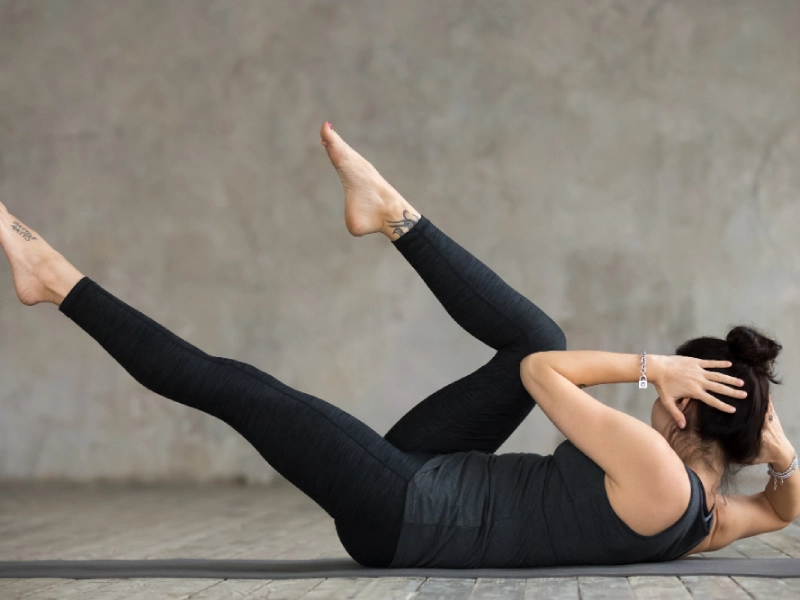
Exercise 1. Criss Cross
- Lie on your back, hands behind your head, elbows wide and knees bent in a tabletop position.
- Lift your head and neck and twist your torso to bring your right elbow towards your left knee as you extend your right leg forward at a 45-degree angle. Switch to the other side.
- Alternate sides, keeping elbows wide and spine neutral. Try inhaling as you twist to one side, then exhale as you twist to the other.
- Aim for 10 to 12 repetitions.
Muscles worked: Deep core muscles, obliques
Exercise 2. Side Kneeling Leg Lift
Kristin likes this exercise because it targets the hips and outer glutes, areas that need to be strong for pelvic stability and power when running, cycling, and squatting.
How to perform:
- Begin by kneeling and leaning to the right, placing your right hand on the mat for support, torso facing forward.
- Lift your left leg off the ground and straighten it.
- Raise your left leg up to hip height, keeping your toes pointing forward.
- Engage your core and obliques while using your hip and outer glute muscles to lower and lift your straight leg. Switch sides.
- Try 10 to 12 repetitions on each side.
Muscles worked: Abdominals, latissimus dorsi, outer hips, glutes
Exercise 3. Teaser
The Teaser is an excellent way to strengthen the deep abdominal muscles, helping cyclists, runners and meditators maintain fitness and prevent injury.
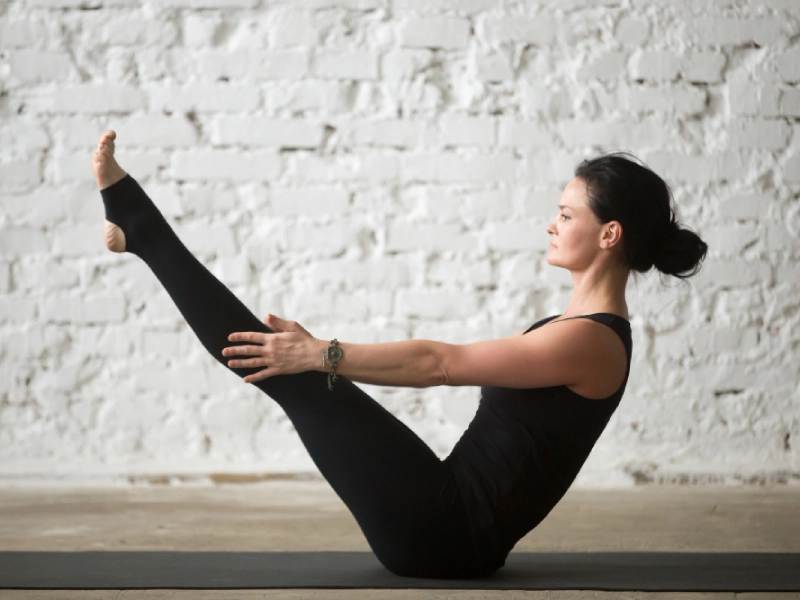
Exercise 3 Teaser.
How to perform:
- Lie on your back, arms raised high, legs straight out in front of you.
- Inhale and simultaneously lift your arms, upper body and legs off the floor, forming a V shape (bend your knees slightly if you need to modify).
- Exhale as you lower your back to the mat.
- Try 3 to 5 repetitions.
Muscles worked: Transverse abdominals, pelvic floor
Exercise 4. Leg Pull Front
The plank is an excellent method for strengthening the entire core as well as the arms. Adding the leg lift truly engages the glutes and teaches you to keep the core active and truly isolate the back in this movement.
How to perform:
- Assume a plank position with legs straight, back flat, and arms extended straight under shoulders.
- Lift the right leg off the floor higher than the hips without shifting the pelvis or lowering the opposite hip.
- Rock forward and backward on the left toes, keeping the body in a long straight line.
- Lower the right leg and repeat on the opposite side.
- Repeat 3 to 5 times.
Muscles worked: Triceps, abdominals, glutes, hamstrings
Exercise 5. Roll Up
This classic Pilates move engages your body while activating your hip flexors. It’s an excellent exercise before running or other cardiovascular activities.
How to perform:
- Lie on the floor with your legs straight and your arms stretched out above your head.
- Inhale and lift your arms, head and neck off the floor.
- Lower your chin towards your chest, engage your abdominal muscles and begin to curl up into a sitting position, vertebra by vertebra.
- Keep your arms raised above your head, then extend them forward and over your toes as you reach forward.
- Exhale, round your back and slowly roll back down to the floor.
- Repeat 5 times.
Muscles worked: Transverse abdominals, hip flexors
Exercise 6. Roll Over
Warm up your entire spine and increase your flexibility with this easy movement. You will build core strength while activating your hamstrings and glutes.
How to perform:
- Lie on your back, bend your knees and bring them towards your chest.
- Place your arms on either side and press them into the mat for support, palms facing down.
- Lift both legs straight up into the air, keeping your feet together, toes pointed.
- Focus on your body and lift your legs over your head, lifting your hips off the floor. Continue stretching your legs until your toes touch the floor behind your head.
- Spread your legs apart about a foot’s length. Flex and extend your feet and roll back to the starting position, keeping your legs straight.
- When your legs are pointing straight up again, bring them together, pointing your toes, and repeat.
- Perform 3 to 5 repetitions.
Muscles worked: Abs, glutes, hamstrings, lower back
Exercise 7. Corkscrew
This movement uses your oblique muscles to stabilise your body while teaching you how to control your muscles.

Exercise 7 Corkscrew.
How to perform:
- Lie on your back with your legs straight and your hands on either side. Press your arms into the mat for stability, palms facing down.
- Lift your legs off the floor and raise them directly above you.
- Engage your abdominal muscles and lift your hips off the floor to balance on your upper back and shoulder blades.
- Keeping your hips and torso stable, release your legs to the left about 30 degrees.
- Roll your spine down so that your back is flat on the floor as you rotate your legs clockwise to the 6 o’clock position (keep your legs about 2 feet off the floor).
- Roll back up your spine as both legs rotate to the 9 o’clock position and then back to the 12 o’clock position, creating a full circle above your body.
- Perform 3 clockwise circles, then 3 counterclockwise circles.
Muscles engaged: Transverse abdominals, obliques, glutes, quadriceps
How long should you warm up for to achieve the best results?
Warming up has many benefits, but it should not be prolonged. It is important to balance the time spent warming up to achieve results while saving training time. When muscles are less tense, the warm-up time can be shortened.
Trainers often recommend maintaining a warm-up for 5-10 minutes. This is a reasonable timeframe for everyone, ensuring sufficient time to warm up the body and relax the muscles. You can choose warm-up exercises based on your physical condition and ability, then adjust the time accordingly.
Notes on performing warm-ups
Warm-ups are an important step in preparing the body for a Pilates session, but not everyone knows how to warm up correctly to achieve the best results. Below are important notes to remember when performing warm-ups before Pilates.
Focus on the major muscle groups
Pilates is a discipline that emphasises body control and flexibility, particularly in the core muscles. Therefore, during the warm-up, you should focus on the major muscle groups such as the abdominal muscles, back muscles, glutes, thighs, shoulder muscles, and arms.
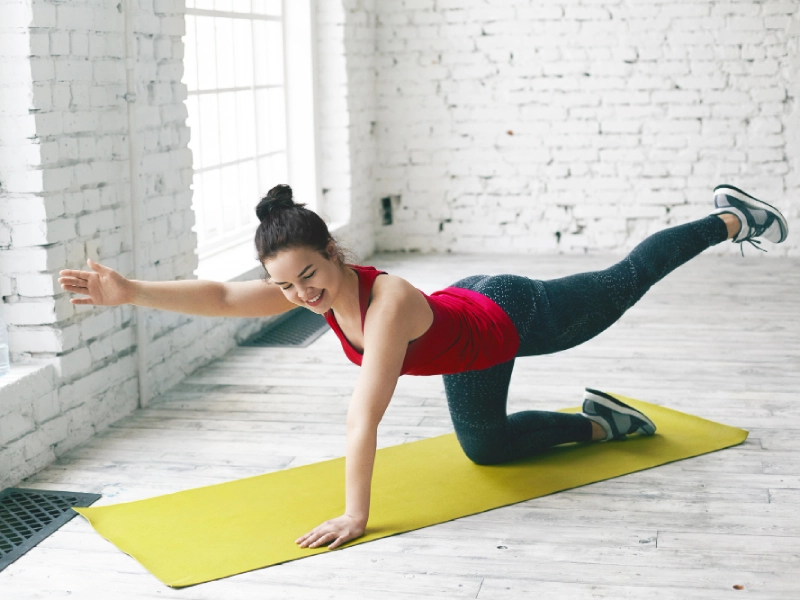
The warm-up process should focus on the major muscle groups.
Do not warm up too quickly or carelessly
One of the common mistakes when warming up is doing it too quickly or carelessly, leading to the body not having enough time to adapt to the intensity of the exercise. This can increase the risk of muscle strain, soreness and reduced training performance.
You should allocate a specific amount of time and begin with gentle movements, gradually increasing the intensity. Avoid performing strenuous exercises right from the start, as this can shock the body and affect the effectiveness of the session.
Pay attention to your breathing
Breathing is a core element of Pilates, helping you maintain control and rhythm during your workout. Right from the warm-up phase, you need to pay attention to regulating your breathing correctly to better connect your body and mind. This also improves your workout performance and prevents you from feeling tired quickly.
Warm up before Pilates is not just a preparatory step but an important part of optimising your workout effectiveness and protecting your body from unwanted injuries. Take a few minutes to do warm-up exercises, and you will feel a noticeable difference in each session. Remember, warming up properly is the key to progressing further on your Pilates fitness journey.


